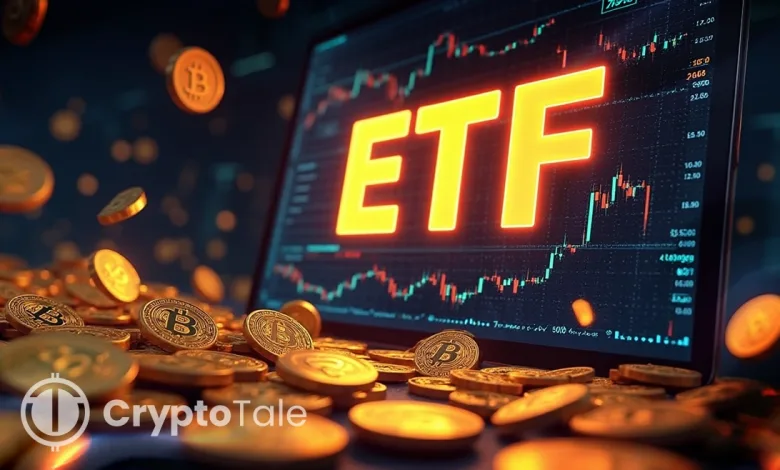Bitcoin ETFs See $902M Outflows on Quarter-End Rebalancing

- Bitcoin ETFs saw $902.5M in outflows as investors rebalanced portfolios at quarter’s end.
- Fidelity and BlackRock products led the outflows, reflecting strong profit-taking.
- Bitcoin remains resilient, with historical Q4 rallies suggesting potential for renewed momentum.
Bitcoin exchange-traded funds in the U.S. recorded heavy redemptions last week, ending a month-long streak of inflows. The $902.5 million in net outflows reflected quarter-end portfolio rebalancing, a common move among institutional investors. The selling came as Bitcoin traded between $108,000 and $112,000, a range that analysts view as consolidation before potential fourth-quarter momentum.
Quarter-End Rebalancing Hits Bitcoin ETFs
Spot Bitcoin ETFs had enjoyed four straight weeks of inflows before last week’s reversal. According to SoSoValue, redemptions totalled $418.25 million on Friday alone, the largest single-day outflow in more than a month. Fidelity’s FBTC led with $300.41 million in withdrawals, while BlackRock’s IBIT lost $37.25 million.
On the other hand, Bitwise’s BITB saw a loss of $23.79 million in redemptions, while the ARK 21Shares ETF recorded $17.81 million in losses. Grayscale’s Bitcoin Mini Trust reported $17.14 million in outflows, alongside $12.57 million from its main trust. Only VanEck’s HODL ETF showed activity on Friday, dropping $9.28 million.
Shawn Young, chief analyst at MEXC Research, described the redemptions as routine profit-taking tied to institutional portfolio management. He emphasized that Bitcoin ETFs are being actively traded within traditional investment strategies.
Ethereum products also faced significant withdrawals. Net outflows reached $796 million, the largest weekly loss since their launch earlier in 2025. Analysts cited macroeconomic caution and the Federal Reserve’s uncertain policy outlook as contributing factors.
Rotation Within Digital Assets
While Bitcoin and Ethereum ETFs struggled, institutional investors shifted attention to alternative assets. Solana-linked and XRP-linked ETFs attracted new inflows despite the rest of the market being weaker. Analysts said the activity showed a rotation rather than a full retreat from crypto exposure.
Solana and XRP products recorded modest but steady allocations in recent sessions. According to the market participants, institutions are considering diversifying along the spectrum of digital assets. The move indicates an increase in the desire to test tokens beyond Bitcoin and Ethereum.
Meanwhile, Bitcoin’s price action demonstrated resilience despite heavy ETF outflows. The asset closed the week near $111,800, up slightly by more than 2% on Sunday. The performance left September gains at 3.2%, even with the pullback from August’s all-time high above $124,000.
Young noted that the lack of sustained selling pressure shows strong absorption by buyers. He said Bitcoin remains in consolidation, awaiting clearer signals from monetary policy and global liquidity. Market watchers believe fourth-quarter trends will determine the next decisive move.
Historically, Bitcoin has recorded good gains during the last quarter of the year. Statistics indicate that average Q4 returns in previous bull cycles have been more than 50%. Analysts argue that this pattern, combined with ongoing institutional adoption, could set the stage for renewed upside.
Related: Bitcoin Tests $109K, Traders Await Buy Signals at $112K
Institutional Mechanics Drive Short-Term Moves
The redemptions underline how the institutional mechanics can easily override crypto momentum in the short term. Investment managers tend to rebalance at the end of the quarter, eliminating investments in risky assets such as digital currencies. This causes a short-term selling pressure despite having long-term demand.
The reset underscores how crypto ETFs now function within broader financial strategies. As digital assets integrate into traditional markets, flows increasingly reflect risk management cycles. Investors must navigate these periodic adjustments while tracking longer-term adoption trends.
Bitcoin continues to consolidate above major support levels, with institutions trying to weigh between the risk and opportunity. The most recent outflows indicate the impact of structured allocation strategies. Yet the fundamentals of Bitcoin, both in supply curves and mainstream ETF adoption, continue to provide a foundation for optimism towards Q4.




